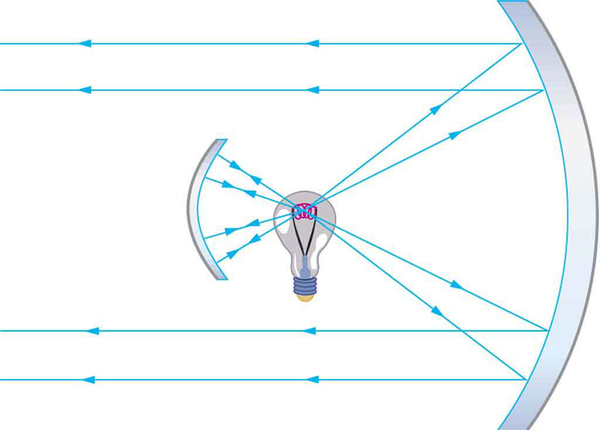| << Chapter < Page | Chapter >> Page > |
The three types of images formed by mirrors (cases 1, 2, and 3) are exactly analogous to those formed by lenses, as summarized in the table at the end of Image Formation by Lenses . It is easiest to concentrate on only three types of images—then remember that concave mirrors act like convex lenses, whereas convex mirrors act like concave lenses.
Find a flashlight and identify the curved mirror used in it. Find another flashlight and shine the first flashlight onto the second one, which is turned off. Estimate the focal length of the mirror. You might try shining a flashlight on the curved mirror behind the headlight of a car, keeping the headlight switched off, and determine its focal length.
Step 1. Examine the situation to determine that image formation by a mirror is involved.
Step 2. Refer to the Problem-Solving Strategies for Lenses . The same strategies are valid for mirrors as for lenses with one qualification—use the ray tracing rules for mirrors listed earlier in this section.
What are the differences between real and virtual images? How can you tell (by looking) whether an image formed by a single lens or mirror is real or virtual?
Can you see a virtual image? Can you photograph one? Can one be projected onto a screen with additional lenses or mirrors? Explain your responses.
Is it necessary to project a real image onto a screen for it to exist?
At what distance is an image always located—at , , or ?
Under what circumstances will an image be located at the focal point of a lens or mirror?
What is meant by a negative magnification? What is meant by a magnification that is less than 1 in magnitude?
Can a case 1 image be larger than the object even though its magnification is always negative? Explain.
[link] shows a light bulb between two mirrors. One mirror produces a beam of light with parallel rays; the other keeps light from escaping without being put into the beam. Where is the filament of the light in relation to the focal point or radius of curvature of each mirror?

Devise an arrangement of mirrors allowing you to see the back of your head. What is the minimum number of mirrors needed for this task?
If you wish to see your entire body in a flat mirror (from head to toe), how tall should the mirror be? Does its size depend upon your distance away from the mirror? Provide a sketch.
It can be argued that a flat mirror has an infinite focal length. If so, where does it form an image? That is, how are and related?

Notification Switch
Would you like to follow the 'College physics' conversation and receive update notifications?